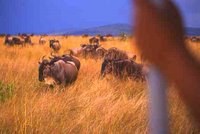 The wildebeest are on the move.
The wildebeest are on the move.Each spring, tens of thousands of wildebeest move north from Tanzania's Serengeti plain and head for the sweet, plentiful grass of the Masai Mara in Kenya. The endearingly ugly, bearded gnu will graze in the Mara until November, then return south to the Serengeti.
In July, the Mara is a sea of wildebeest. The Jeeps and Rovers and kombi vans that take camera-toting tourists out on dawn and evening game drives phase the gnu not at all. They chomp and stare and nuzzle and sashay while tourist vehicles ply thin dirt tracks that cut right through herds that can number in the hundreds. The annual migration is a visual feast for tourists. And a literal feast for lions.
During the blazing midday hours, lions sleep in the grass behind rocks and boulders and in the shade of the wispy acacia trees that dot the savannah. Tourists sleep, read, swim or gather at the bar at their fenced camps and lodges, passing the hot hours until the evening game drive. While lions and tourists rest, wildebeest graze unmolested.
About 4 p.m., safari vehicles roll out of the gates and bump across rutted tracks in search of game. Lions stir. Wildebeest become wary.
Near the end of our second evening drive on the Mara, our Star Travel and Tours guide, Herbert, a master at finding wildlife and delivering us into scenes of such utter animal majesty that we often could not speak, motioned for us to be still and, about 10 yards from a collection of tall gray stones half-hidden by thick shafts of golden grass, cut the engine of our white pop-top van and pointed toward the rocks, on our left. A herd of some 50 wildebeest, many babies, stood stock still on our right. The distance between rocks and gnu was less than a hundred feet. We’d been with Herbert for a few days and knew we were going to see something special.
It was 6:15. Our lodge imposed a 6:30 p.m. deadline on vehicle drivers. All vehicles carrying tourists were to be inside the lodge gates by 6:30. Searches would be mounted for any vans not accounted for by that deadline, and the drivers would be reprimanded (unless they’d been eaten). Herbert had a habit of cutting things close, but every risk he took was, we’d learned, wisely calculated, and we trusted him.
The wildebeest stared and seemed unsettled. Mothers stood near their young. Some in the herd had begun galloping lightly on the spindly legs that didn’t seem to match their meaty bodies. They bounced and bounded, then reversed direction in quick, snapping turns. Then they’d stop and stare, beards brushing the tops of the tallest grass.
The grass near the rocks began to move, and, with Herbert’s finger to guide us, we made out a pride of seven lions silently slinking closer to the road we sat on – and to the wildebeest, who were clearly on guard. The lions’ stealth was at once frightening and awesome. They moved as a strategically trained unit under the direction of a young, maneless simba. He moved his pride of mature females and fit cubs through the grass, inch by inch.
6:20, 6:25. The lodge gates, miles away, were about to close, and the rest of the tourists were already tossing back Tuskers at the lodge bar. We had to go. The lion pack was at the road, a few feet from our van. Herbert started the key in the ignition, and we looked at the wildebeest, wondering which of them would go down tonight.
At 6:30 the next morning, we met Herbert and left for a dawn game drive. Spellbinding is too weak a word to describe the early morning Mara.
While the evening drive shows you the hunt – meat-eaters planning canny, quiet takedowns of plant-eaters – the dawn drive shows you the hunters’ handiwork and the manic collection of carrion eaters who feast on remains the hunters couldn’t finish. Evening is for predators, dawn for scavengers.
Two lionesses and three cubs, bellies bulging with wildebeest, crossed the road in front of our van, languidly making their way back to their resting place on a low, rocky hillock. They’d sleep until evening.
Herbert parked the van, and we watched four wild-eyed hyenas, snouts flaring, dash through the brush to rip chunks of flesh or a spindly leg from a nearly-stripped wildebeest. They tore their prizes off quickly, and emitted sick-sounding yelps as they slunk off to chew before darting back to the kill. The hyenas were covered in blood. Hyenas do kill, in packs. But wildebeest season affords them the lazy option of letting lions do the work. Lions take the lions’ share, but then the hyenas eat leftovers for free. Hyenas may be ugly, but they're not stupid. Why break a sweat if you don’t have to?
Jackals nipped at the wildebeest flesh, and whenever one scored a piece, one or more hyena would reign terror on the jackal, chasing him through the savannah until he dropped the meat. Between hyena raids, swarming vultures picnicked on the gnu’s head and neck. Lustily. They approached the remains with ugly, hopping gaits and spread their wings as if to keep outsiders from their meal. They made a smacking, sucking noise as they descended upon the bloody, bodyless head.
When the wildebeest had been stripped, save for the hair on his face and forehead, the hyenas gathered for dessert. We watched as they raised ribs and femurs to their loud lips and listened to the sound of teeth crunching bone.
I looked up from the scene and watched a hot air balloon, brilliant stripes against the purplish-blue rising of the sun, ferry well-heeled tourists, at $350 a head, high over the Mara on a dawn champagne flight.
I pitied them for what they were missing.
www.LoriHein.com
